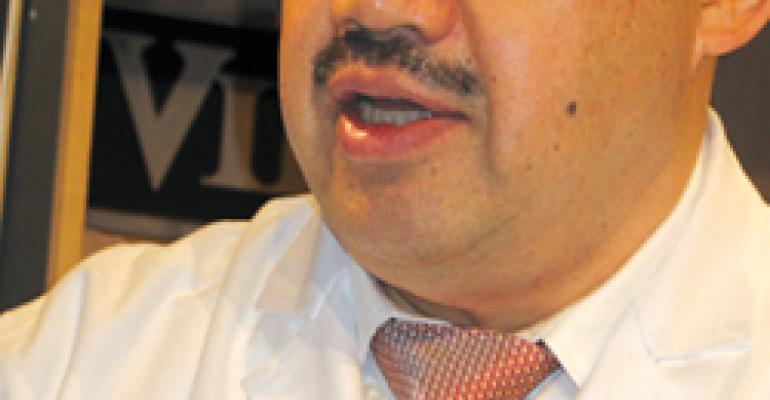Kaiseki chef Kenichi Hashimoto studied pottery and was already a published poet before he decided to enter the restaurant business in 1973, in a space owned by his family in Kyoto, Japan. Nine years later, he wrote a book on how to open a restaurant, which in 1983 was made into a Japanese television series. On the show the chef played an “extra” posing as a customer.
These days he is back in the spotlight promoting the foods of his country with kaiseki-style meals. He demonstrated the style of cooking this spring in New York at The Japanese Food Culture Festival orchestrated by Japan External Trade Organization, or JETRO. After this event Hashimoto discussed kaiseki menus, among other things. He said he incorporates “playfulness” into his meals. For instance, Japanese children are taught to quickly pick food from platters. So the chef said he purposely tries to confuse adults by offering a course with many selections. As a result, confused guests may then linger over the choices and return to their inner child, he explained.
At the Japanese Food Culture Festival you prepared a dish called “Sound of Spring Creek.” Would you explain the name and describe the dish?
BIOGRAPHY Title: owner-manager of Ryozanpaku in Kyoto, Japan Hometown: Kyoto, Japan Birth date: May 1, 1948 Career highlights: writing five cookbooks, visiting France with the Confrérie des Chevaliers du Tastevin; being a member of The Japanese Culinary Academy, a Kyoto based chefs’ organization
Under the creek, as the snow starts melting in the spring, you start to hear the sound of a creek. It is needlefish with sudachi, a small citrus like Key lime, powdered salt from Okinawa Island and house-made soy sauce.
How do you make soy sauce?
That is a top secret.
Do you use soy or wheat for the base?
Both.
Why do you make it yourself?
The flavor of mine is rich, however, it is light in salt and doesn’t kill the flavor of white fish. And it is more healthy.
Do you focus on healthful cooking? Can you describe your restaurant?
It is entertaining and full of fun. The passion you get while you eat is the same passion you get when you are in love. However the passion you have when you are in love lasts a short time. The passion from eating can last forever.
That’s a poetic response.
My poetry was published when I was young, in my 20s.
And you also studied pottery?
Yes, I was still thinking of doing pottery even 10 years after opening the restaurant. I made 80 percent of the plates used since we opened.
How does kaiseki work? How many courses do you offer and how is the meal ordered?
There are 10 or 14 courses per meal. Texture is important. For every single meal I put something that requires chewing, like dried squid. The first bite you don’t taste anything. After chewing the flavor comes.
How long does the meal take to consume?
About two to two-and-a-half hours. Although each restaurant makes their own rules. For mine there is a starter—or a gate to a house. It has two or three dishes on a single plate. The second appetizer—like a driveway or path to the house—is another mouthful size. The taste should be unique like an uni sauce. And it depends on the season.
Is kaiseki based on seasonality?
In Japanese culture we always try to express the past, the present and the future. In order to express this you have to take advantage of seasonality.
The third dish—the door or entrance—is a soup, like dashi that is based on bonito flakes and soy. That is the greeting of water from the well. The fourth is sashimi and the next is a simmered dish, a fish, followed by a grilled dish.
Is there meat?
Kaiseki started as part of a Buddhist culture where they don’t eat meat.
What are the last few courses?
The seventh can be 15 or 20 little dishes on a plate—a flower field. In Japan a flower field comes right before the peak of a mountain. On purpose I try to make it as confusing as possible. It is the playful part of kaiseki. The next is a fried dish—the climax. That is followed by seasonal ingredients with a vinaigrette made to shock you back into reality. Then a rice or soup.
No dessert?
Maybe a mashed potato shaped like a shrimp that is not sweet, but served warm. And in the spring I may add strawberries to a custard.
Please describe your typical guest.
CHEF’S TIPS For the freshest rice, purchase grains that are milled weekly, because freshness escapes rapidly once milled. To clean small needlefish, soak them for about 20 minutes in a salt water mixture using 5 percent salt. Then rinse the seafood with fresh water.
It is upscale for most people. You have to dress up to eat it.
What is the average check at your restaurant?
For food only, $150 per person. Lunch is kaiseki only and dinner is kaiseki and à la carte.
How can learn more about cooking kaiseki-style?
By going to many kaiseki restaurants. Kaiseki is very conceptual. And unlike in France, where each meal is divided by ingredients, kaiseki is divided by techniques. Eating is not just filling yourself up.

